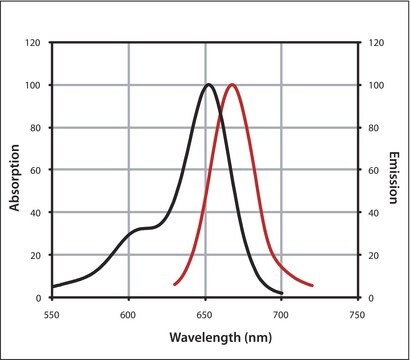Wszystkie zdjęcia(1)
Key Documents
07679
Abberior® STAR 635P, NHS ester
suitable for fluorescence
Zaloguj sięWyświetlanie cen organizacyjnych i kontraktowych
About This Item
Kod UNSPSC:
12352108
NACRES:
NA.32
Polecane produkty
masa cząsteczkowa
Mw 1030 g/mol
rozpuszczalność
DMF: 0.25 mg/mL, clear
fluorescencja
λex 634 nm; λem 654 nm±10 nm in PBS, pH 7.4
przydatność
suitable for fluorescence
temp. przechowywania
−20°C
Opis ogólny
Abberior STAR635P is the first member of an entirely new class of dyes introduced exclusively by Abberior - first commercially available phosphorylated fluorescent dye. The dye excels in its photophysical parameters, e.g. very bright, very stable and it enables basically background free imaging.
Abberior STAR 635P can substitute Atto™ 647N, AlexaFluor 647, or Cy5. It can be excited with diode lasers (635 nm, 650 nm) or with the 647 nm line of a Krypton laser. For STED, a depletion wavelength of 750 - 780 nm is recommended. Please see reference1 for detailled characteristics.
Best results are obtained with freshly prepared samples.
Abberior STAR 635P particularly well suits the Leica TCS STED system and delivers high-resolution STED images with unmatched quality, e.g. extremely low/no background. The dye serves as an ideal partner for several 2-color STED.
Key Features
Absorption Maximum, λmax: 638 nm (PBS, pH 7.4)
Extinction Coefficient, ε(λmax): 120′000 M-1cm-1 (PBS, pH 7.4)
Correction Factor, CF260 = ε260/εmax: 0.21 (PBS, pH 7.4)
Correction Factor, CF280 = ε280/εmax: 0.40 (PBS, pH 7.4)
Fluorescence Maximum, λfl: 651 nm (PBS, pH 7.4)
Recommended STED Wavelength, λSTED: 750 - 780 nm
Fluorescence Quantum Yield, η: 0.90 (PBS, pH 7.4)
Fluorescence Lifetime, τ: 3.3 ns (PBS, pH 7.4)
Abberior STAR 635P can substitute Atto™ 647N, AlexaFluor 647, or Cy5. It can be excited with diode lasers (635 nm, 650 nm) or with the 647 nm line of a Krypton laser. For STED, a depletion wavelength of 750 - 780 nm is recommended. Please see reference1 for detailled characteristics.
Best results are obtained with freshly prepared samples.
Abberior STAR 635P particularly well suits the Leica TCS STED system and delivers high-resolution STED images with unmatched quality, e.g. extremely low/no background. The dye serves as an ideal partner for several 2-color STED.
Key Features
- First phosphorylated dye
- Unmatched, background free STED imaging contrast
- Verified in the Leica STED system
Absorption Maximum, λmax: 638 nm (PBS, pH 7.4)
Extinction Coefficient, ε(λmax): 120′000 M-1cm-1 (PBS, pH 7.4)
Correction Factor, CF260 = ε260/εmax: 0.21 (PBS, pH 7.4)
Correction Factor, CF280 = ε280/εmax: 0.40 (PBS, pH 7.4)
Fluorescence Maximum, λfl: 651 nm (PBS, pH 7.4)
Recommended STED Wavelength, λSTED: 750 - 780 nm
Fluorescence Quantum Yield, η: 0.90 (PBS, pH 7.4)
Fluorescence Lifetime, τ: 3.3 ns (PBS, pH 7.4)
Przydatność
Designed and tested for fluorescent super-resolution microscopy
Inne uwagi
Informacje prawne
Atto is a trademark of Atto-Tec GmbH
abberior is a registered trademark of Abberior GmbH
This page may contain text that has been machine translated.
produkt powiązany
Numer produktu
Opis
Cennik
Kod klasy składowania
11 - Combustible Solids
Klasa zagrożenia wodnego (WGK)
WGK 3
Temperatura zapłonu (°F)
Not applicable
Temperatura zapłonu (°C)
Not applicable
Certyfikaty analizy (CoA)
Poszukaj Certyfikaty analizy (CoA), wpisując numer partii/serii produktów. Numery serii i partii można znaleźć na etykiecie produktu po słowach „seria” lub „partia”.
Masz już ten produkt?
Dokumenty związane z niedawno zakupionymi produktami zostały zamieszczone w Bibliotece dokumentów.
Klienci oglądali również te produkty
Sören Brandenburg et al.
Frontiers in physiology, 9, 1227-1227 (2018-10-24)
Rationale: Recently, abundant axial tubule (AT) membrane structures were identified deep inside atrial myocytes (AMs). Upon excitation, ATs rapidly activate intracellular Ca2+ release and sarcomeric contraction through extensive AT junctions, a cell-specific atrial mechanism. While AT junctions with the sarcoplasmic
Nasz zespół naukowców ma doświadczenie we wszystkich obszarach badań, w tym w naukach przyrodniczych, materiałoznawstwie, syntezie chemicznej, chromatografii, analityce i wielu innych dziedzinach.
Skontaktuj się z zespołem ds. pomocy technicznej

